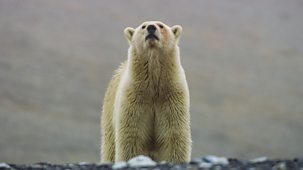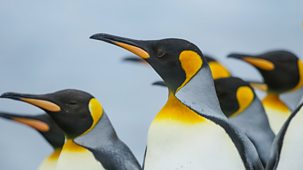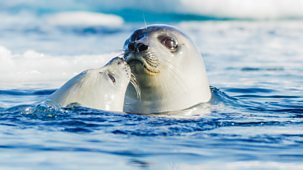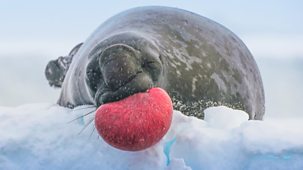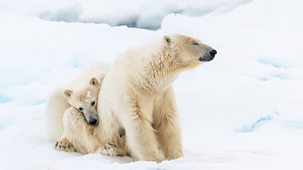
Series 1: 5. Frozen Lands
In the far north of our planet lies the largest land habitat on earth, home to snow-covered forests and the icy open tundra. These are lands of extremes that push animals to their limits: in winter they are so cold that much of the ground has remained frozen since the last ice age. To stand any chance of survival, animals must adapt in extreme ways: here a super pack of wolves, 25 strong, has come together to take on the only large prey available to them in winter, American bison. \n\nOn the featureless tundra, an Arctic fox must strike a living alone. She is a wanderer and will roam many hundreds of miles searching for tiny lemmings, hidden deep underground. The only way to reach them is with a head dive. In the remote far east of Russia, a rare Amur leopard prowls the seemingly empty, snow-covered forest. With little prey available, it must use its ingenuity to find a meal. It follows crows in the hope of finding carrion, but it must not stay long, for it shares the forest with a far larger but equally hungry big cat, the Siberian tiger.\n\nAs spring arrives, the forests begin to thaw and life returns. Beneath the ground, a nest of tiny painted turtle hatchlings now emerge, having remained frozen in a state of suspended animation throughout winter. To the north, it is a further month before the sun’s warmth baths the frozen ground of the tundra. Tucked away underground lies a tiny snow queen – a Lapland bumble bee. She is the sole survivor of her colony - the rest perished in the winter freeze - but her larger size, her furry body and antifreeze in her blood have allowed her to survive. Now she is in a hurry. She must feed herself and raise a brood in the brief window of summer while the flowers are in bloom.\n\nSnowy owls also use the open tundra to breed: one pair have raised a nest full of fluffy chicks. With 24-hour daylight in which to hunt, the dedicated parents bring back meal after meal for their ever-growing brood. But one day, they return to find the nest empty…\n\nToday, the biggest challenge in the tundra is climate change. Warming summers are melting the permafrost deep within the soil, causing the ground to thaw and, in places, the land to collapse. These changes are impacting the animals too. Caribou arrive in herds of 200,000 individuals to raise their calves in the rich pastures, but warming means mosquitos emerge sooner and bother the calves before they have had a chance to gain strength. The parents drive their young to cooler, mosquito-free land, but to get there they must cross rivers running with increased meltwater and escape hungry grizzly bears. They, like much of the tundra's wildlife, are adapted to live in the extremes - but the challenge of today’s warming climate could be one extreme too many.
Source: BBC 1
Most recent episodes of Frozen Planet II
Frozen Planet Ii
Series 1: 6. Our Frozen Planet
Our frozen planet is changing. In this final episode, we meet the scientists and people dedicating their lives to understanding what these changes mean, not just for the animals ...
07-04-2025
BBC 1
Frozen Planet Ii
Series 1: 5. Frozen Lands
In the far north of our planet lies the largest land habitat on earth, home to snow-covered forests and the icy open tundra. These are lands of extremes that push animals to the ...
03-04-2025
BBC 1
Frozen Planet Ii
Series 1: 4. Frozen South
Antarctica is the most hostile of all earth’s frozen worlds. Yet even here, amongst some of the most challenging conditions on the planet, life finds a way not just to sur ...
02-04-2025
BBC 1
Frozen Planet Ii
Series 1: 3. Frozen Peaks
Mountains create frozen habitats on every continent on Earth, and each of these high-altitude worlds hold unique challenges for its surprising and remarkable life.\n\nWe begin o ...
01-04-2025
BBC 1
Frozen Planet Ii
Series 1: 2. Frozen Ocean
At the top of our planet lies a magical realm, the Arctic Ocean. After four months of winter darkness, the sun returns to reveal a frozen ocean covered in ice. Mother polar bear ...
31-03-2025
BBC 1
Frozen Planet Ii
Series 1: 1. Frozen Worlds
Journeying from pole to pole, we reveal the surprising frozen worlds that exist across the planet and the remarkable animals that make them their home. \n\nWe begin our journey ...
27-03-2025
BBC 1
Frozen Planet Ii
Worlds Of Wonder
This special episode brings together highlights from the series in a journey from the Arctic to the Antarctic.\n\nWe begin on the frozen Arctic Ocean. It’s the end of wint ...
02-01-2025
BBC 1
Most popular episodes of Frozen Planet II
Frozen Planet Ii
Series 1: 6. Our Frozen Planet
Our frozen planet is changing. In this final episode, we meet the scientists and people dedicating their lives to understanding what these changes mean, not just for the animals ...
07-04-2025
BBC 1
Frozen Planet Ii
Series 1: 1. Frozen Worlds
Journeying from pole to pole, we reveal the surprising frozen worlds that exist across the planet and the remarkable animals that make them their home. \n\nWe begin our journey ...
27-03-2025
BBC 1
Frozen Planet Ii
Series 1: 3. Frozen Peaks
Mountains create frozen habitats on every continent on Earth, and each of these high-altitude worlds hold unique challenges for its surprising and remarkable life.\n\nWe begin o ...
01-04-2025
BBC 1
Frozen Planet Ii
Series 1: 2. Frozen Ocean
At the top of our planet lies a magical realm, the Arctic Ocean. After four months of winter darkness, the sun returns to reveal a frozen ocean covered in ice. Mother polar bear ...
31-03-2025
BBC 1
Frozen Planet Ii
Worlds Of Wonder
This special episode brings together highlights from the series in a journey from the Arctic to the Antarctic.\n\nWe begin on the frozen Arctic Ocean. It’s the end of wint ...
02-01-2025
BBC 1
Frozen Planet Ii
Series 1: 5. Frozen Lands
In the far north of our planet lies the largest land habitat on earth, home to snow-covered forests and the icy open tundra. These are lands of extremes that push animals to the ...
03-04-2025
BBC 1
Frozen Planet Ii
Series 1: 4. Frozen South
Antarctica is the most hostile of all earth’s frozen worlds. Yet even here, amongst some of the most challenging conditions on the planet, life finds a way not just to sur ...
02-04-2025
BBC 1


